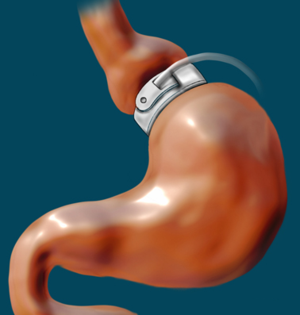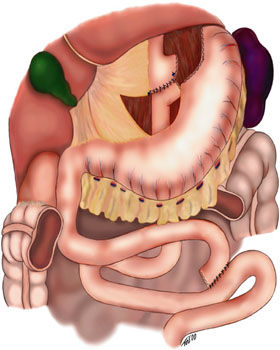- Written by Site Staff
- On Aug 07 2013,
- In Gastric Sleeve Surgery
Gastric Sleeve For Weight Loss – The Fastest Obesity Cure?
During gastric sleeve surgery, around 70-80% of the stomach is permanently removed, leaving a banana shaped “sleeve” or “tube” as the remaining usable portion that holds much less food than before. None of your intestines are rerouted during the procedure.
After the gastrectomy comes the gastric sleeve post op diet. It has four different stages, where the fourth and last stage is to be followed for the rest of your life. They are intended to first help heal the stomach and then to gradually transition into a well-balanced diet that will keep you healthy and happy.
Several effective surgical procedures exist to provide long-term solutions for patients who suffer from lymphedema. Prior to any lymphedema surgery, patients typically have been treated by a physical therapist trained in providing lymphedema treatment for initial conservative treatment of their lymphedema. CDT, MLD and compression bandaging are all helpful components of conservative lymphedema treatment.
The gastric sleeve diet is significantly less restrictive than the diets of other fat loss surgeries. With this diet regime you are able to just about eat anything you choose – that said, for the diet to be a success you will want to watch the volume of fat, carbs and sweets that you eat.
I can put in a paragraph about IFSO, and a link to their website, which is operated as a subpage of a privately operated info website out of Austria. It does not have a listing of member surgeons, except national society officers. It has no referral service – surgeons must list with the parent site, for a fee.
The gastric sleeve diet is significantly less restrictive compared to diets of many other weight loss surgical treatments. On this diet you can just about consume anything you want – however, in order for the diet to be a success you will want to watch the quantity of fat, carbohydrates and sweets you take in. Certain spices might also need to be eliminated. The standard post surgical diet with this type of bariatric surgery is split into several stages.
The gastric sleeve surgery can restrict the amount of food you eat, since the procedure involves the surgical removal of a large portion of the stomach that reduces the size of the stomach to about 25% of its original size. However, the surgery cannot restrict the kind of food you eat. So, even if you are eating small portions of food, you could be eating calorie rich foods that will not let you lose the amount of weight you need to lose. In fact, many people gain the weight back by not following the diet long-term.
Reference 3, to the Swedish Obese Subjects study published in NEJM, states in its “Adverse Events” section: “Within 90 days after surgery, five subjects in the surgery group (0.25%) and two subjects in the control group (0.10%) died.”
Head and neck lymphedema can be caused by surgery or radiation therapy for tongue or throat cancer. It may also occur in the lower limbs or groin after surgery for colon, ovarian or uterine cancer, in which removal of lymph nodes or radiation therapy is required. Surgery or treatment for prostate, colon and testicular cancers may result in secondary lymphedema, particularly when lymph nodes have been removed or damaged.
Separately, but in parallel with Kuzmak, Hallberg and Forsell in Stockholm, Sweden also developed an adjustable gastric band. After further work and modifications this eventually became known as the Swedish Adjustable Gastric Band (SAGB).
What happens 6-12 years Post Op? Everything I see in this article deals with the short term and mostly what happens in the first year after gastric bypass. I’m three years post op and it seems that I really have to get off the program to regain even 10 lbs. Wondering if others also have to go to extremes of eating and being sedentary to regain weight?
It represents roughly 2% (25,500 cases) of all new cancer cases yearly in the United States, but it is more common in other countries. It is the leading cancer type in Korea, with 20.8% of malignant neoplasms.
What to keep in mind when having this type of surgery is very important. The Gastric Sleeve Surgery procedure started in England around the year 2002 as a solution and weight loss procedure for patients with a greater Body Mass Index of 3. It was proved to be very safe and very effective. The results where remarkable and now it´s being practiced all over the world with bariatric surgeons, who performed this procedure since the first one done in England. During this procedure, the surgeon removes approximately 50 to 80 percent of the stomach using the laparoscopic method. In the first step of the surgery the surgeon makes a tube out of the stomach by using staples to hold it together. The portion of the stomach that is stapled is then removed out the patient´s body. This results in a much smaller sized stomach, taking the shape of a “sleeve” .
Posts related to Gastric Sleeve For Weight Loss - The Fastest Obesity Cure?
by Site Staff
Categories
Recent Posts
-
Gastric Sleeve Post Op Diet
Aug, 13, 2013
-
Gastric Sleeve Surgery – Benefits and ...
Aug, 12, 2013
-
The Gastric Sleeve Diet
Aug, 09, 2013
-
Considering Gastric Sleeve Surgery?
Aug, 08, 2013
-
Gastric Sleeve For Weight Loss – The F...
Aug, 07, 2013
-
Diagnostic Laparoscopy
Aug, 06, 2013
-
Gastric Band Surgery
Aug, 06, 2013















